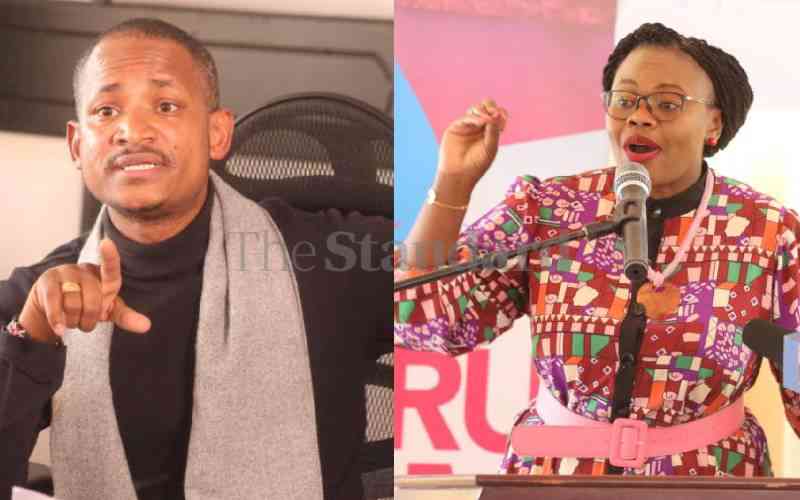NAIROBI: That we are overrepresented, nay misrepresented, in elective and appointive political seats is not in question. The question is when and how do we correct this anomaly?
Many proposals on public reassessments over this issue through a plebiscite have been put forward. It is obvious our 'expert' imaginations on 'inclusion' got stretched in the new constitutional design. A quick monitoring will concretely show mismatch of representatives and interests. In the National Assembly, there is a nominated male octogenarian who is neither a minority nor youth. Brazen cronyism is at play in counties, where few constituent sectors know those purportedly nominated for them. Nothing stands out more than the special seats which are just a reward system for loyalties.
Former nominated MP and now Supreme Court Judge Njoki Ndung'u, and now nominated MP Isaac Mwaura stand out for women and people with disabilities in exceptional tribute to deserved special interests' representations. They have envious legislative records.
Representation is the anchor of democracy. Events leading to the American Revolution were escalated by the Boston Tea party of 1773 in which protesters destroyed chests of tea seized from the British East India Company at the Port of Boston. They were galvanised by the clarion call "No taxation without representation." Taxation by the British monarchy without their representation became untenable.
Elective representation in Kenya currently has about 1,450 members of County Assembly, 290 members of Parliament, 47 Senators, 47 women representatives, 47 county governors and their deputies as well as the President and his deputy. These are positions occupied by full time politicians and other state officers with monthly paychecks, and attendant pensions and gratuities.
Enquiry on representation maintains the complex nature of the concept, of course in essence emphasising the commitment to participation of different interests. In theory, therefore, various interest groups are given the opportunity to have their voices in decision making. This is done through direct allocations of seats or alternatively, providing them with the opportunity to elect a representative to the house of authority. Representation is therefore about votes, elective offices and the diversities of interests negotiated politically.
The US has a bicameral legislature. At the primary level, it has the House of Representatives with no more than 435 seats comprising elected congress-persons from the 50 states. Then there is a powerful Senate with two senators from each state. The population is about 400 million. Roughly estimated, Kenya is only one state of the US federal states, but with a much pale state of economy. I hasten to underscore the economic comparison since in the real sense; there is an affordability question to representation.
Put differently, if the American Federal States, each one of them under an elected Governor were to be ranked as independent national economies, California (with a Population of about 39 million people) would be the fifth richest country in the world! This means the US can easily underwrite the costs of its heavy political administration.
Senators and members of the House of Representatives discuss and vote on federal legislation touching on all aspects of US domestic and foreign policy. At the state levels, governance is similarly arranged into a local senate as well as assembly. There is also local government consisting of cities, counties and district agencies. Our Constitution attempted to borrow from the US representative model.
Comparatively and nearer home, South Africa and Ethiopia set in new constitutions in the 1990s, which instituted federal governments with elaborate representation models similarly crafted to harness broad group interests.
Representation in the political process in South Africa is also through a bicameral parliament made up of the National Assembly as well as the National Council of Provinces. There are nine provinces in South Africa and each province elects ten representatives to the Assembly. The provinces have their own legislatures (of between 30-80 members). The South African national Parliament has about 400 MPs but the country is the wealthiest in Africa.
Illustratively, multi-faceted legislative representations became popular responses to the problem of citizen voicelessness and the urge to meet diverse interests in the political process. It should be borne in mind that the Executive and the Judiciary are other arenas for the representation question as well. As such, the issue is not exhausted by looking at the parliamentary institutions alone. Besides direct participation, the mechanics of representation require legitimate democratic institutions that can shore up citizen engagements.
In our yearning for democratic growth, we definitely craved a system of governance that would embrace the different shades of socio-political cleavages. This should however be sustainable. As we inspect the bolts and nuts of our Constitution going forward, the greater challenge is aligning true representation, not reward.
 The Standard Group Plc is a
multi-media organization with investments in media platforms spanning newspaper
print operations, television, radio broadcasting, digital and online services. The
Standard Group is recognized as a leading multi-media house in Kenya with a key
influence in matters of national and international interest.
The Standard Group Plc is a
multi-media organization with investments in media platforms spanning newspaper
print operations, television, radio broadcasting, digital and online services. The
Standard Group is recognized as a leading multi-media house in Kenya with a key
influence in matters of national and international interest.
 The Standard Group Plc is a
multi-media organization with investments in media platforms spanning newspaper
print operations, television, radio broadcasting, digital and online services. The
Standard Group is recognized as a leading multi-media house in Kenya with a key
influence in matters of national and international interest.
The Standard Group Plc is a
multi-media organization with investments in media platforms spanning newspaper
print operations, television, radio broadcasting, digital and online services. The
Standard Group is recognized as a leading multi-media house in Kenya with a key
influence in matters of national and international interest.







